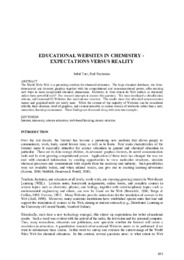Educational websites in chemistry - expectations versus reality
Abstract
The World Wide Web is a promising medium for chemical education. The huge chemical databases, the threedimensional and dynamic graphics together with the computational and communicational power, offer exciting new ways to learn complicated chemical phenomena. However, to what extent do Web authors in chemistry utilize these powerful tools? Our research attempts to answer this question. We have developed a classification scheme, and examined 95 Websites that teach atomic structure. The results show that advanced communication means and graphical tools are rarely used. While the content of the majority of Websites can be considered reliable, their structure, level of graphics, and content resemble an online version of textbooks rather than a new, interactive, learning environment. These findings are discussed along with concrete examples.
